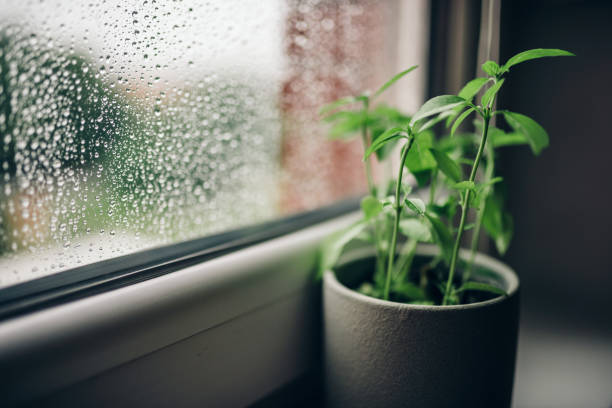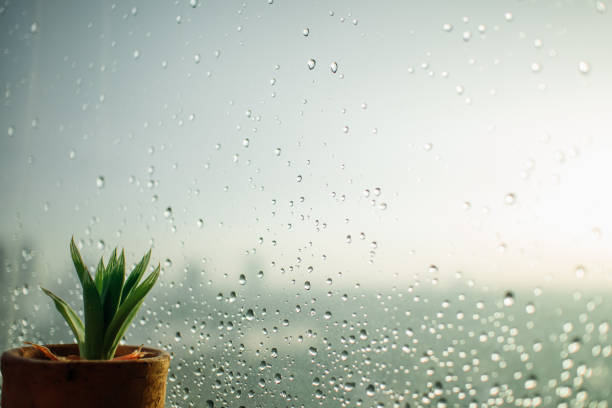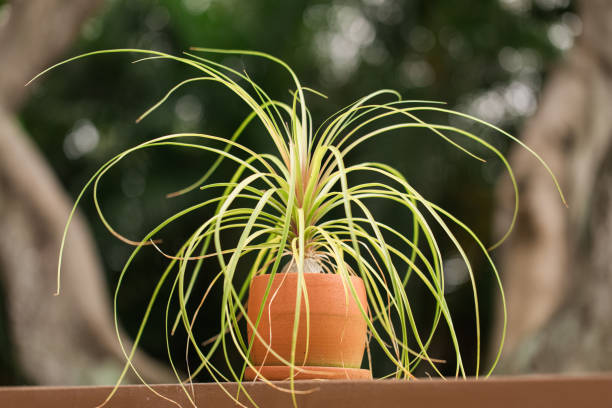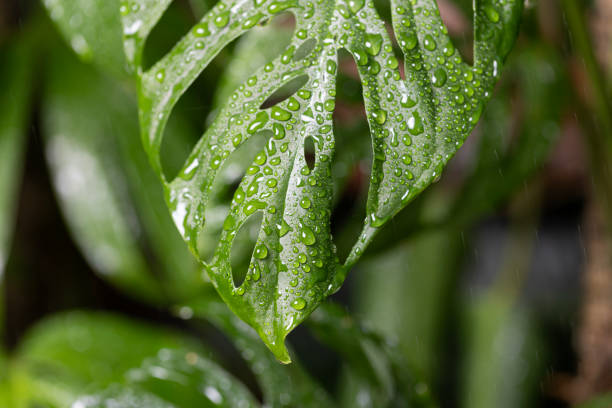“Rainy days may refresh trees and fill rivers, but for container gardening, too much rain and high humidity can spell trouble—causing root rot, fungal infections, and pests. Here’s how I’ve learned to handle it.”
Dealing With High Humidity on Rainy Days in Container Gardening:
The rainy season has its own perks. It refreshes the trees, keeps the surroundings green, and fills our agricultural and human water needs. Even for container gardening, rain can be a blessing in small doses—giving plants natural nitrogen and washing off dust from leaves.
But when the rainy days stretch too long, no sunny breaks, high humidity, and too much water exposure in pots can quickly turn into container gardening chaos—leading to overwatering problems, fungal infections, and pest infestations.
Myth to Debunk: “Rain Automatically Means Plants Are Happy”
This is one of the biggest myths in container gardening. The truth? Rain doesn’t always equal healthy plants.
When pots keep receiving excess water—even if you’re using well-draining soil and have plenty of drainage holes—the air pockets in the potting mix fill up with water. This blocks oxygen flow to the roots, creating the perfect environment for fungal infections and root rot.
On top of that, standing water on the topsoil and around pots attracts mold, fungus gnats, mosquitoes, and even reptiles during the monsoon. The consistently damp weather also encourages pests that thrive in humid environments.
Many beginners wonder: “Why do ground plants look lush after rain while my potted plants struggle?”
The reason is simple:
- Ground plants benefit from natural nitrates in rainwater, which boost foliage growth.
- The soil in the ground drains excess water easily, avoiding the suffocation that happens in pots.
- Container plants can’t drain fast enough, so they suffer from prolonged wet feet.
Why High Humidity Affects Container Plants Differently?
In container gardening, high humidity means slower evaporation and constantly damp soil. This not only stresses roots but also weakens leaves. During continuous rain, leaves stay wet for hours, and their stomata (tiny pores that release oxygen and take in carbon dioxide) can get clogged by water and fungal spores, slowing down photosynthesis.
That’s why potted plants are more sensitive to heavy rains compared to in-ground plants.
How I Handle High Humidity Issues Without Spending Much
Over the years, I’ve learned to manage high humidity in container gardening with simple, budget-friendly tricks instead of expensive products. These small actions—like improving airflow, adjusting watering, and DIY drainage fixes—have saved many of my green babies during the monsoon.
In the upcoming sections, I’ll share practical tips to prevent fungal infections in container plants during the rainy season, how to fix waterlogged pots, and the best humidity-friendly plants for balconies and terraces.
Why High Humidity Is a Hidden Enemy for Container Plants

The science is simple. When you get occasional showers with sunny gaps, pots usually bounce back—the soil gets time to dry and that rainwater (which can carry tiny amounts of nitrogen compounds) rinses leaves clean.
But during the South Indian monsoon, especially around October in Tamil Nadu, the rain can be consistent. There’s no real drying window. That’s when water fills the air pockets in the potting mix, blocking oxygen to roots and setting the stage for root rot and fungal diseases. On cloudy, sunless days, evaporation slows, leaves stay wet for hours, and photosynthesis drops—another stress layer for potted plants.
My Lived Experience (Dindigul, South India)
Monsoon here is unpredictable. I’ve watched massive grey clouds roll in, gusty winds shake tall plants, and lightning turn night into day. In my early gardening years, I let every pot take “rain baths.” Back then I used terracotta and concrete pots—heavy, yes, but porous and forgiving in wet weather.
As my plant count grew, I shifted to plastic pots—affordable and lightweight for a solo gardener—but non-porous, so they hold moisture longer. That change taught me to move plastic-potted plants to a covered roof or balcony during long rainy spells. It prevents overwatering, reduces high-humidity stress, and even stops pots from toppling in stormy winds.
Myth to debunk: “Rain automatically means plants are happy.”
In containers, too much rain + no sun = suffocated roots, leaf diseases, and pests.
Common Signs Your Plants Are Struggling in Humid Weather
Here’s what I’ve faced in heavy monsoon and high humidity:
- Yellowing leaves from low light (light stress) and nutrient leaching in outdoor pots.
- Droopy, mushy stems or a sour/foul smell—classic waterlogging signals.
- Green algae or mold on topsoil; sometimes fungus gnats buzzing around.
- Leaf spots and powdery/mildew patches after days of leaf-wetness.
- Nutrient washout in mixes exposed to prolonged rain.
Quick fixes that work for me:
- If you see water pooling on topsoil, tilt and drain the pot immediately and move it to a covered, airy spot (veranda/roof ledge).
- In very humid zones, use more porous pots (terracotta, fabric grow bags) or add pot feet/bricks to lift pots and improve drainage.
- Keep plants neatly pruned and spaced to boost air circulation and reduce pest hideouts.
- For plastic pots, extra drainage holes and a lighter, airier mix help (cocopeat + chunky perlite/sand + compost; avoid overly fine textures during monsoon).
- Rinse leaves after long wet spells and shake off trapped water from crowns to reduce fungal pressure.
Why Ground Plants Look Lush While Pots Struggle
- In-ground soil drains laterally and deeply, so roots don’t stay waterlogged.
- Rainwater can carry small amounts of nitrogen, giving foliage a short-term boost (it’s not a fertilizer replacement, just a perk).
- Container plants are confined; when the mix is saturated, oxygen drops fast, fungi thrive, and roots suffocate.
What I Actually Do (Budget-Friendly, Monsoon Routine)
- Before a rain stretch: move sensitive pots to indirect rain; stake tall plants.
- During continuous rain: skip watering, check drainage daily, and rotate pots for better light.
- After heavy rain: drain saucers, top up with slow-release compost if nutrients seem washed out, and use neem oil/bio-fungicide preventively on problem-prone plants.
Pot choice: prefer terracotta/fabric in peak monsoon; keep plastic for covered spots.
Myth-Busting – Rain Takes Care of All Plant Needs

Myth: “You don’t need to water or check soil during rainy days.”
Debunk: This is where most container gardeners go wrong.
If you leave small and delicate potted plants (under 2 feet) in direct heavy rain, be prepared to lose them. Occasional drizzle or a gentle shower is actually beneficial—it gives soil time to dry out between rains, replenishes moisture naturally, and provides a small nitrogen boost that keeps leaves looking fresh and green.
But back-to-back monsoon rain days in high-humidity weather are a different story. Continuous, high-intensity rain can:
- Damage the potting mix, washing away nutrients.
- Topple lightweight pots or erode soil around the roots.
- Cause foliage damage from the sheer force of raindrops.
- Combine with stormy winds that shake plants violently, leaving them stressed or even knocked over.
Another overlooked issue? Less sun exposure during monsoon. Cloudy skies mean reduced photosynthesis. Plants become weaker, slower to recover from stress, and more vulnerable to fungal infections, pests, and soil-borne diseases.
And about “not checking the soil”—that’s a dangerous habit. In monsoon, you must reduce watering, even if pots are moved indoors or under a roof. The air itself is humid, so evaporation slows. But soil monitoring becomes more important than ever. Regularly check for:
- Excess moisture that suffocates roots.
- Early signs of fungal growth or mold on the topsoil.
- Soil-borne pests like slugs, snails, and fungus gnats.
- Nutrient leaching, which can leave plants pale and weak.
Bottom line: Rain doesn’t remove your responsibility—it increases it. Soil checks during monsoon are critical for healthy container gardening.
Personal Note: I still remember one October evening in Dindigul when a sudden storm rolled in. The wind was so strong that my small hibiscus and chrysanthemum pots toppled over, soil washed out, and a couple of weak stems snapped. At that time, I thought the rain would “nourish” them, but instead I lost two plants overnight. That’s when I realized—rain is a blessing only in moderation; for container plants, it can just as easily become a curse.
Practical Tips for Managing High Humidity in Containers (Budget-Friendly)

Container gardening is often praised as affordable and space-saving. But sometimes social media creates an illusion that you need aesthetic, expensive products to succeed.
Speaking from 7–8 years of container gardening experience, I can confidently say it’s not pricey gadgets that make plants thrive—it’s about ticking the basic care boxes and adapting with simple hacks.
Whatever the season, these low-budget and no-budget tricks can help you keep your green babies safe, especially during the humid monsoon months in South India.
Simple Airflow Tricks
- Prune before monsoon begins, pruning plants keeps them in shape, reduces hiding spots for pests, and limits moisture buildup on leaves. It also makes pots lighter and easier to move if sudden heavy rains arrive.
- Space pots at least 1.5 feet apart. This improves ventilation so moisture dries out faster, reducing fungal spread and pest infestations.
- Choose porous pots in humid zones. Terracotta, concrete pots, or fabric grow bags allow faster drying and better root aeration. Non-porous materials like plastic, metal, or glass pots trap moisture, causing prolonged dampness.
- Already using plastic or metal pots? Improve drainage by adding a layer of coconut husk chips at the bottom, drilling extra holes, and always using a well-draining potting mix (cocopeat + compost + sand/perlite).
Cheap & Easy Hacks
- Elevate pots. Keep pots slightly raised from the tray or floor so excess water drains quickly. If using stands, place the tray under the stand instead of directly under pots.
- Use coconut husk chips between pots and trays. This small gap helps water flow out and prevents roots from sitting in stagnant water.
- Remove attached trays after rain. Drain manually to avoid hidden water that encourages pests and foul smells.
- Bottom Trays are useful. They collect water, prevent messy soil stains, and can be managed better with small tweaks like using gravel at the base.
Case Study: What Worked for Me in Dindigul Rainy Days
I grow plants in two main spots:
- Front yard (concrete pots, open space near car shed):
These pots don’t mind the rain because concrete is naturally porous. Combined with drainage holes, a well-draining soil mix, and raised bases, my herbs stay healthy even in consistent showers. - Terrace garden (plastic pots, roof-covered but side-open):
About 80% of my plants live here. They get gentle drizzles during heavy rains but avoid direct downpours. In normal seasons I keep them in the open sun, but during the monsoon, I shift them under the roof edge.- I reduce watering completely during continuous rainy days and only water when the topsoil looks dry.
Drainage layers, porous soil mix, and consistent checks make my monsoon routine less stressful and more plant-friendly.
💨 Think wiping leaves is enough? Think again. Discover smarter dust-cleaning hacks for terrace plants in India.
Seasonal Care – Adjusting Gardening Routine During Monsoon

The monsoon season in India isn’t the same as a gentle drizzle—it’s days of continuous showers, cloudy skies, and high humidity. Container plants need a slightly different care routine during this time.
- Adjust your watering schedule. During heavy rains, I completely cut back on watering. Even if pots are indoors, the naturally humid weather slows down evaporation. I only water after checking the topsoil moisture—if it’s still damp, I hold back. This avoids root rot, one of the most common monsoon container gardening problems.
- Move sensitive plants temporarily. Some plants, especially those under 2 feet or with delicate foliage, can’t handle constant heavy rain. I usually shift my chrysanthemums indoors or under a covered roof where they still get diffused light but avoid direct downpours.
- Tougher plants like hibiscus stay outside. Hibiscus loves humidity and can handle monsoon showers well. They just need good drainage. My tip: raise hibiscus pots with bricks or pot feet to stop waterlogging.
- Regular checkups. Monsoon means fungus and pests appear overnight. I monitor pots weekly for slugs, fungus gnats, mold on topsoil, and yellowing leaves. Quick action prevents bigger losses.
Best Plants That Thrive in High Humidity
Not all plants hate humidity—some absolutely love it. Through trial and error, here are my reliable picks for monsoon-friendly container plants in South India:
- Money Plant (Pothos): A true humidity lover. Whether in soil or water, pothos thrive in the damp, making it a low-maintenance option.
- Ferns: High humidity is exactly what ferns crave. They look even fresher in the monsoon season, just make sure they’re not in direct, harsh rain.
- Hibiscus: My personal favorite. It not only tolerates humidity but rewards with lush green leaves and vibrant blooms if drainage is right.
- Areca Palm (bonus pick): Another plant that handles humid balconies well, adding a tropical vibe without demanding much.
Tip: If you live in a monsoon-dominated area, start your container collection with these humidity-tolerant plants. They naturally save you from overwatering headaches.
Quick Fixes if You Already See Damage
Even with all the precautions, sometimes the rain wins. Here’s my go-to routine when I notice damage in my potted plants during the rainy season:
- Pruning: I remove yellowing, infected, or soggy leaves immediately. This reduces the spread of fungal infections and helps plants refocus energy on healthy growth.
- Repotting (if roots are suffocating): If I see consistent waterlogging or smell a foul odor from soil, I take the plant out, trim off rotted roots, and repot it in fresh, well-draining potting mix with added sand or perlite.
- Neem Spray: My budget-friendly rescue tool. I make a simple neem oil solution and spray it on foliage and topsoil to deter fungus, gnats, and mites.
Real Case From My Garden: Gardenia Root Rot Rescue
Two years ago, my gardenia nearly died after a stretch of back-to-back monsoon showers. The leaves turned yellow, soil smelled sour, and roots were mushy when I pulled it out. Instead of giving up, I:
- Trimmed off the rotted roots,
- Repotted it into a fresh mix (cocopeat, sand, compost),
- Shifted it under a semi-covered roof to protect from direct rain,
- Sprayed neem oil weekly.
In a month, new leaves sprouted—and now that gardenia is one of my strongest bloomers. That experience taught me: don’t panic, act quickly, and most plants bounce back.
FAQs About Container Gardening in High Humidity
Can I prune plants in the rainy season?
Yes, light pruning is not only safe but actually helpful during monsoon. When I prune in early rains, it improves air circulation for container plants and reduces hiding spots for pests. I usually snip away yellow, soggy, or overlapping branches before the peak rainy spell hits. Just don’t go overboard—heavy pruning can stress the plant when humidity is already high.
Should I fertilize plants during monsoon humidity?
This is one of the biggest myths—many believe feeding plants in the monsoon makes them lush. In reality, humidity slows nutrient uptake, and excess fertilizer may even burn roots in waterlogged soil. What I do is pause chemical fertilizers and stick to light organic feeds like liquid fertilizer or diluted seaweed extract once in 3–4 weeks. This keeps plants healthy without overloading them.
How often should I water potted plants on rainy days?
Honestly, I water far less in the monsoon. Sometimes, I skip watering for 4–5 days straight because humidity keeps the soil damp. My golden rule: always check the top 1–2 inches of soil—if it’s moist, no watering. Overwatering is the quickest way to cause root rot in potted plants during monsoon. For terrace gardens that get only drizzles, I water lightly once soil dries out.
What’s the best fungicide for home garden plants?
I prefer starting with natural remedies first. A simple neem oil spray mixed with mild soap has saved me from fungus countless times. For severe fungal attacks, I’ve used a homemade baking soda solution as a preventive spray. If nothing works, only then I use a mild organic fungicide from the nursery. But honestly, early action—like pruning and improving airflow—is the best defense.
Final Thoughts
Gardening in high humidity is never about getting it “perfect.” It’s a mix of mistakes, experiments, and learning what works for your plants in your unique space. After 7–8 years of container gardening, I can tell you this: even small adjustments—like smarter watering, better drainage, or pruning before the rains—can save a whole season’s effort.
If you’re struggling with your rainy-season plant care, you’re not alone. Every container gardener I know has lost a plant or two to humidity, including me. The important part is noticing the signs early, making budget-friendly fixes, and not chasing Instagram-style perfection.
👉 I’d love to hear your experiences: What’s the biggest challenge your plants face in monsoon humidity? Drop your story in the comments—I learn as much from fellow gardeners as I do from my own pots!
👉 Read my blog on post-monsoon plant care tips for container gardens to help your plants recover and thrive after the rains.
🌱 If you found this guide useful, you might also like my other posts:
- Best Potting Mix for Potted Plants
- Watering Routine That Actually Saves Plants
- 👉 Read my blog on eco-friendly Diwali tips for potted plants to celebrate the festival of lights without harming your greens.
Pingback: Self-Watering vs Regular Pots: 5 Honest Lessons I Learned
Pingback: 6 Smart & Easy Tips to Shield Pots from Heavy Rain on Budget